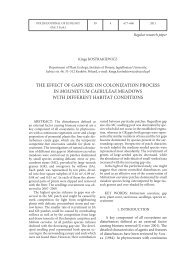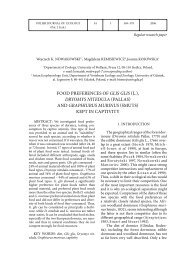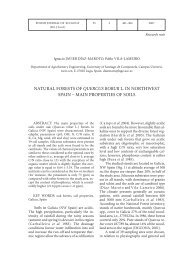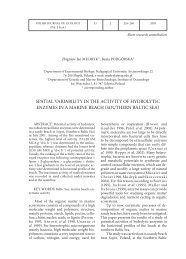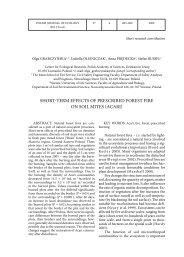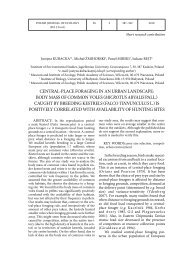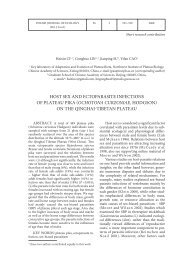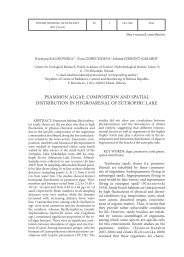FACTORS DETERMINING THE DISTRIBUTION OF COEXISTING ...
FACTORS DETERMINING THE DISTRIBUTION OF COEXISTING ...
FACTORS DETERMINING THE DISTRIBUTION OF COEXISTING ...
Create successful ePaper yourself
Turn your PDF publications into a flip-book with our unique Google optimized e-Paper software.
POLISH JOURNAL <strong>OF</strong> ECOLOGY<br />
(Pol. J. Ecol.)<br />
54 3 379–386 2006<br />
Short research contribution<br />
Botond BAKÓ 1 , Kristóf HECKER 2<br />
1<br />
Office of Nature Conservation, Költő u. 21, H-1121, Budapest, Hungary<br />
2<br />
Department of Zoology and Ecology, Szent István University, Páter Károly u. 1., H-2103, Gödöllő,<br />
Hungary, e-mail: hecker.kristof@mkk.szie.hu<br />
<strong>FACTORS</strong> <strong>DETERMINING</strong> <strong>THE</strong> <strong>DISTRIBUTION</strong><br />
<strong>OF</strong> <strong>COEXISTING</strong> DORMOUSE SPECIES (GLIRIDAE, RODENTIA)<br />
ABSTRACT: This study investigated coexistence<br />
of three dormouse species living in the<br />
same habitat, Naszály-hill, in the north-eastern<br />
part of the Danube-bend (47°49’N, 19°08’E). The<br />
vegetation of the area is very diverse, comprising<br />
a mosaic of orchards with natural forests and forest<br />
plantations. Data were collected from 1999 to<br />
2005 with wooden nest boxes and from 2002 to<br />
2005 also plastic nest tubes were used. Study area<br />
was approximately 6 ha.<br />
All three species (hazel dormouse Muscardinus<br />
avellanarius L., forest dormouse Dryomys<br />
nitedula Pall. and fat dormouse Glis glis L.) have<br />
different ecological requirements. However, they<br />
occurred simultaneously in some microhabitats<br />
and in some places one species clearly predominated.<br />
We also observed how the ongoing succession<br />
process in the former orchards affected the<br />
distribution of dormice.<br />
There were seasonal differences in timing of<br />
emergence from hibernation, greatly affecting spatial<br />
distribution of the different species. Hazel dormice<br />
were first to appear in nest boxes and/or tubes,<br />
in March, then forest dormice in April and fat dormice<br />
in June. As numbers of fat dormice increased<br />
the smaller species withdrew from using the nest<br />
boxes. Fat dormice reached peak numbers in summer<br />
and they entered hibernation by October.<br />
KEY WORDS: dormouse, coexistence, habitat,<br />
environmental factors, nest box/tube<br />
The coexistence of several dormouse<br />
species in one locality with different habitat<br />
types offers a unique possibility to study<br />
habitat preference of the species.<br />
Our research site, the Naszály-hill, has<br />
been known as a habitat of all three dormouse<br />
species that occur in Hungary (Bakó<br />
and Gál 1999, Gál 1999). Our first studies<br />
began in 1995 using live-traps. Based on the<br />
early results we started an improved research<br />
project in 1999. The aim of our study was to<br />
find out, which environmental factors enable<br />
the coexistence of different dormouse species<br />
in one area and to observe how the adjacent<br />
vegetation types and the ongoing succession<br />
process affect the spatial distribution of the<br />
coexisting dormouse species. Research topics<br />
also included the seasonal and yearly differences<br />
in the appearance and occupancy of<br />
nest boxes/tubes by the dormice.<br />
The study area (in total ca. 6 ha),<br />
Naszály-hill (652 m a.s.l.), lies near the<br />
city of Vác in the north-eastern part of the<br />
Danube Bend (47°49’N, 19°08’E). Mainly<br />
dachstein limestone, with dolomite in some<br />
places, dominates in the bedrock and contains<br />
nine caves of different size. The vegetation<br />
is extraordinarily diverse as it lies<br />
on the ranges of the distribution area of<br />
journal 7.indb 379 2006-09-23 11:28:41
380 Botond Bakó, Kristóf Hecker<br />
Fig. 1. Site map of the location showing the woody vegetation patches.<br />
Legend to the numbers of patches see in Table 1.<br />
Table 1. Main and other abundant tree and shrub species in the different vegetation types and the size<br />
of the plots where dormice were surveyed.<br />
No. Vegetation type Main species Other abundant species<br />
Size<br />
of plot<br />
No. of boxes<br />
1999/2002/<br />
2005<br />
1.<br />
Hedge around<br />
abandoned orchard<br />
dogwood (Cornus<br />
sanguinea L.), plum<br />
(Prunus domestica L.)<br />
dogrose (Rosa canina L.),<br />
cherry (Cerasus avium /L./<br />
Moench), privet (Ligustrum<br />
vulgare L.)<br />
0.6 ha 70/50/50<br />
2. Shrub dogwood dogrose, cherry, privet 0.5 ha –/50/50<br />
3. Young pine stand<br />
Austrian pine (Pinus<br />
nigra Link)<br />
privet 0.3 ha –/50/50<br />
4. Abandoned orchard plum<br />
dogwood, common lilac<br />
(Syringa vulgaris L.)<br />
0.6 ha 35/35/38<br />
5. Mixed pine forest<br />
Scots pine (Pinus sylvestris<br />
L.)<br />
ash (Fraxinus excelsior L.)<br />
0.6 ha –/12/35<br />
6.<br />
Edge of oak-hornbeam<br />
forest<br />
sessile oak (Quercus<br />
petraea /Matt./ Liebl.)<br />
hedge maple (Acer campestre<br />
L.), ash<br />
0.7 ha 35/21/35<br />
7.<br />
Oak-hornbeam<br />
forest<br />
sessile oak<br />
hornbeam (Carpinus betulus<br />
L.), hedge maple<br />
0.6 ha –/50/50<br />
8. Turkey oak forest<br />
turkey oak (Quercus<br />
cerris L.)<br />
white oak (Quercus pubescens<br />
Willd.), ash<br />
0.7 ha –/–/70<br />
journal 7.indb 380 2006-09-23 11:28:41
Distribution of coexisting dormouse species<br />
381<br />
different flora units (Füri and Sinkóné<br />
Póka 1996). Natural and planted vegetation<br />
plots also change in space and time.<br />
Beside the different types of grassland there<br />
are planted hedges and orchards, with different<br />
fruit trees (mostly apple, plum and<br />
pear). Most of the orchards have been out<br />
of cultivation for decades, but some are<br />
still in use. The mixed oak forests (Quercus<br />
petraea (Matt.) Liebl., Quercus cerris L.,<br />
Quercus pubescens Willd.) both with dense<br />
and sparse underbrush, and planted pine<br />
forest (Pinus sylvestris L. and Pinus nigra<br />
Link) of different age occur in the area.<br />
The older pine forests are already mixed<br />
with ash (Fraxinus excelsior L.), some areas<br />
are monocultures of young pines. On the<br />
top of the hill a beech (Fagus sylvatica L.)<br />
forest (Gál 1999) occurs.<br />
Populations of the three dormouse<br />
species: hazel dormouse Muscardinus avellanarius,<br />
fat dormouse Glis glis and forest dormouse<br />
Dryomys nitedula occur in the study<br />
area (Bakó and Gál 1999, Gál 1999).<br />
From 1999 to 2005 nest boxes were<br />
used to collect data. They were placed along<br />
a transect across different vegetation types<br />
like an abandoned orchard, a hedgerow and<br />
the edge of a deciduous forest dominated by<br />
sessile oak (Quercus petraea) (Bakó et al.<br />
2002).<br />
The first 150 wooden bird nest boxes<br />
(height 30 cm, width 15 cm and depth 15 cm)<br />
were set up for dormice in autumn 1999,<br />
they were followed by 150 plastic nest tubes<br />
(height 10 cm, width 10 cm and depth<br />
30 cm) in summer 2002 (Bakó et al. 2002).<br />
In spring 2005 additionally 70 new wooden<br />
dormouse nest boxes (20 × 20 × 20 cm) and<br />
35 new plastic nest tubes were introduced.<br />
The boxes were fixed at 1.5–2.5 m above the<br />
ground, 5 m apart, the wooden ones faced<br />
the tree trunk, the plastic tubes were on<br />
horizontal branches. This height was found<br />
to be suitable for dormice and easy to check<br />
(Morris 2004). With this nest box density<br />
the availability of nesting places is not a limiting<br />
factor (Bright et al. 1994, Juškaitis<br />
2003, 2006).<br />
First observations suggested that a nest<br />
tube made mainly of smooth plastic was not<br />
fully suitable, although several nestings were<br />
recorded. So we roughened the inner surfaces<br />
with sand. Some nest boxes were lost<br />
for various reasons, but with the new ones we<br />
managed to complete the data series.<br />
Eight vegetation types were surveyed<br />
with nest box system (Table 1), and their location<br />
can be seen in Fig. 1.<br />
We checked the nest boxes and nest tubes<br />
monthly and cleaned them only in winter.<br />
We collected data on animals found: after<br />
sexing the animals were weighed, body and<br />
tail length and the length of the left ear and<br />
left hind foot were measured. Empty nests<br />
were also recorded, but only the new nests<br />
were included in the data processing.<br />
The total occupation in the wooden<br />
boxes and plastic nest tubes (Figs 2 and 3) is<br />
a sum of the records on dormice, observed<br />
new nests, food remains, faeces and other<br />
signs of activity. There were differences in<br />
the use of the two different nest box types,<br />
so in spring 2005 we started a comprehensive<br />
investigation to find out how this difference<br />
influenced the results (Fig. 4). Muscardinus<br />
was the only dormouse species<br />
successfully breeding in plastic tubes, Glis<br />
and Dryomys were found only few times.<br />
There were 16 nest boxes and tubes (5.7%),<br />
which were never used (no nest or any sign<br />
of occupation) mainly in the area of the<br />
planted young pine stand (5 plastic tubes)<br />
and the oak forest (8 plastic tubes) with<br />
sparse underbrush.<br />
In the years 2000–2005 we had a total of<br />
341 records on dormice. The percentage of<br />
species can be seen in Fig. 5.<br />
Although not all vegetation plots are adjacent<br />
to each other, there are no geographical<br />
barriers or habitat corridor gaps between<br />
them. So, theoretically all surveyed plots can<br />
be reached by the animals. Moreover, there<br />
are neighbouring vegetation types, which<br />
have different plant species composition.<br />
Muscardinus was the only dormouse species<br />
found in every plot, and the only species<br />
in the young pine stand and the shrub (Fig. 6).<br />
We got less records from the hedge in the<br />
last three years, but at the same time the<br />
number of hazel dormice in the neighbouring<br />
pine stand and shrub increased. In the<br />
plots where Glis was very abundant (orchard,<br />
edge of oak-hornbeam forest, turkey oak forest),<br />
only few records of Muscardinus were<br />
obtained.<br />
journal 7.indb 381 2006-09-23 11:28:41
382 Botond Bakó, Kristóf Hecker<br />
Fig. 2. Changing in the occupancy by dormice (%) of the wooden nest boxes by dormice during the<br />
whole study period (2000–2005).<br />
Fig. 3. Changing in the occupancy by dormice (%) of the plastic nest tubes during the study period<br />
(2002–2005).<br />
Glis was absent from the shrub habitat<br />
and the young pine stand, as was Dryomys<br />
(Fig. 6). Dryomys was also absent from the<br />
edge of oak-hornbeam forest. Glis occurred<br />
in higher numbers in the hedge, orchard, edge<br />
of oak-hornbeam forest and in the turkey oak<br />
forest, while most data on Dryomys were collected<br />
in the abandoned orchard (Fig. 6).<br />
All three species occurred in five out of<br />
eight plots: hedge, orchard, mixed pine forest,<br />
oak-hornbeam forest and turkey oak forest,<br />
although in the oak-hornbeam forest, we<br />
found only a single Glis and Dryomys.<br />
The results on seasonal distribution<br />
showed (Fig. 7) that dormice used the nest<br />
boxes to a different extent. Muscardinus used<br />
nest boxes/tubes during the whole active season,<br />
Dryomys numbers peaked in May and<br />
some specimens could be found in August.<br />
Glis was found mostly in late summer and<br />
autumn, when they appeared to play a very<br />
dominant role.<br />
journal 7.indb 382 2006-09-23 11:28:41
Distribution of coexisting dormouse species<br />
383<br />
Fig. 4. Proportion of monitored animals, nests<br />
and other signs of activity in the turkey oak forest<br />
in the two different nest box types (per 100 nest<br />
box checks).<br />
Fig. 5. Percentage of the dormouse species in the<br />
total number of caught dormice.<br />
Fig. 6. Proportion of three<br />
dormouse species caught<br />
in the different vegetation<br />
types (per 100 nest box<br />
checks)<br />
Legend:<br />
1. hedge,<br />
2. shrub,<br />
3. young pine stand,<br />
4. abandoned orchard,<br />
5. mixed pine forest,<br />
6. edge of oak-hornbeam<br />
forest,<br />
7. oak-hornbeam forest,<br />
8. turkey oak forest<br />
* boxes placed in 2002,<br />
** boxes placed in 2005<br />
journal 7.indb 383 2006-09-23 11:28:41
384 Botond Bakó, Kristóf Hecker<br />
Fig. 7. The average number of dormouse individuals in all boxes in the different months of the whole<br />
survey period (2000–2005).<br />
Other species nesting in the boxes were<br />
Apodemus flavicollis Melchior, Apodemus<br />
sylvaticus L., Parus major L., Parus caeruleus<br />
L., Jynx torquilla L., Vespa crabro L. and Bombus<br />
terrestris L.<br />
The number of records on dormice collected<br />
during our survey confirms that the<br />
use of nest boxes/tubes for surveys provided<br />
a good source of data (Robel and Leitenbacher<br />
1993, S chlund et al. 1993, Morris<br />
1997, S orace et al. 1998, 1999, Juškaitis<br />
1995, 1999, 2000, Koppmann-Rumpf et<br />
al. 2003, Bakó et al. 2002). There was difference<br />
in the use of wooden boxes and plastic<br />
nest tubes. The preliminary results of the<br />
comprehensive investigation let us suppose<br />
that fat dormice avoid the plastic nest tubes,<br />
forest dormice seem to make no difference,<br />
whereas hazel dormice nested mainly in the<br />
plastic tubes. In an earlier study we found<br />
out that Muscardinus made no difference<br />
between the two types of nest boxes, but<br />
Dryomys and Glis had a clear preference to<br />
wooden boxes (Hecker and Bakó 2005).<br />
These observations show that records gained<br />
using wooden nest boxes are more reliable<br />
for all three species. We think this is because<br />
the inner hole is bigger in the wooden nest<br />
boxes and more suitable for Glis, but even for<br />
Dryomys, because the only two forest dormice<br />
found in the nest tubes in 2005 were juveniles.<br />
We think that Muscardinus used the<br />
tubes more because of the competition with<br />
the other dormouse species. However the<br />
wooden boxes are heavier and it is hard to<br />
fix them on shrubs. Probably the size is more<br />
important than the material, so it would be<br />
useful to test larger plastic nest boxes e.g. of<br />
the size of wooden nest boxes.<br />
The species composition changed in<br />
2005. Before that year hazel dormouse was<br />
the most abundant similarly to nationwide<br />
trends (Hecker et al. 2003). In 2005, 139<br />
records were obtained on Glis, which made<br />
41% of all dormouse records during whole<br />
study period. Observed increase in Glis numbers<br />
might have been caused by the change in<br />
acorn production, as it was observed in other<br />
studies (S chlund et al. 2002). However, we<br />
did not monitor acorn production to support<br />
this statement, but a lot of the nest boxes and<br />
plastic nest tubes were filled up with acorn<br />
shells much more than in previous years.<br />
The differences in distribution of dormouse<br />
species cannot be explained only by<br />
spatial factors. All but one of the plots were<br />
adjacent to one or more plots, and all were<br />
linked together by forest patches or habitat<br />
corridors. The largest difference in species<br />
composition was found between the hedge,<br />
journal 7.indb 384 2006-09-23 11:28:42
Distribution of coexisting dormouse species<br />
385<br />
with all three dormouse species present,<br />
and the neighbouring shrub and young pine<br />
stand, only with Muscardinus.<br />
Those habitats where all three dormouse<br />
species occurred contained various tree<br />
and shrub species, providing food (fruits or<br />
seeds) at different times. By contrast, in the<br />
shrub where dogwood (Cornus sanguinea L.)<br />
dominated or in the young pine stand only<br />
few shrub species provided source of food.<br />
Dryomys was the only species, which was<br />
not found at the edge of oak-hornbeam forest.<br />
It agrees with the results of the former<br />
survey (Gál 1999). However, in the neighbouring<br />
oak- hornbeam forest one Dryomys<br />
was recorded in 2005.<br />
There are certain microhabitats where<br />
mainly or only hazel dormice appear: young<br />
pine stand, shrub, oak-hornbeam forest. The<br />
changes of the spatial distribution found<br />
during the five years of our survey suggest<br />
that the increase of Glis forced back Muscardinus<br />
to the habitats with less species-rich<br />
structures. In the last three years of the study<br />
(2002–2005) we observed a decrease in the<br />
records on Muscardinus in the hedge but at<br />
the same time the numbers in the adjacent<br />
shrub and young pine stand increased.<br />
In the last years vegetation succession<br />
was very intensive, because the orchards<br />
were taken out of cultivation. The shrub vegetation<br />
(Viburnum L., Prunus L. and Euonymus<br />
L. species) has got thicker and formed a<br />
more continuous habitat. This is a possible<br />
reason why more fat dormice appeared in<br />
the hedgerow and numbers of Dryomys increased<br />
in the abandoned orchard.<br />
Data on seasonal distribution show that<br />
nest boxes were used in the whole active season,<br />
but to different extent. The decrease in<br />
using of nest boxes by Muscardinus and Dryomys<br />
in July–August might be due to the late<br />
re-appearance of Glis after hibernation. Glis<br />
probably forced out the smaller dormouse<br />
species. In some cases we found gnawed skin<br />
of young Dryomys and Muscardinus specimens<br />
in Glis nests, which confirms the strong<br />
competition between the species. To answer<br />
these questions we started a field survey in<br />
a location where only Dryomys and Muscardinus<br />
occur.<br />
Our results showed that coexistence of<br />
different dormouse species was possible in<br />
the same habitats – even in nest boxes next to<br />
each other. In our study site we found noticeable<br />
differences between the influence of the<br />
vegetation types and structures, but a more<br />
detailed field survey is needed to explore interspecies<br />
behaviour patterns.<br />
REFERENCES<br />
Bakó B., Gál I. 1999 – Habitat Preference of<br />
Dormouse Species in Naszály Region of Hungary<br />
– IV th International Conference on Dormice<br />
(Rodentia, Gliridae), Book of Abstracts,<br />
Edirne, pp. 4.<br />
Bakó B., Hecker K., Kis Zs. 2002 – Using<br />
of Nest Boxes in Studies on the Vegetation<br />
Preference by the Three Dormouse Species in<br />
Hungary – V th International Conference on<br />
Dormice (Myoxidae), Abstracts, Szent István<br />
University, Gödöllő, pp. 27.<br />
Bright P.W., Mitchell P., Morris P.A.<br />
1994 – Dormouse Distribution: Survey Techniques,<br />
Insular Ecology and Selection of Sites<br />
for Conservation – J. Appl. Ecol. 31: 329–339.<br />
Füri A., Sinkóné Póka M. 1996 – Vác/<br />
Naszály-hegy [Vác/Naszály-hill] (In: Magyarországi<br />
települések védett természeti értékei<br />
[Protected natural values of Hungarian<br />
settlements] Ed. J. Tardy) – Mezőgazda Kiadó,<br />
Budapest, pp. 424–425 (in Hungarian).<br />
Gál I. 1999 – A magyarországi pelefajok (Myoxidae)<br />
élőhelypreferencia vizsgálata [Investigation<br />
on the Habitat Preference of Dormouse Species<br />
(Myoxidae) in Hungary] – Thesis – Agricultural<br />
University of Gödöllő (in Hungarian).<br />
Hecker K., Bakó B. 2005 – Life history of different<br />
nest box types occupied by dormice. 6 th<br />
International Conference on Dormice (Gliridae),<br />
20–24 September 2005, Siedlce, Poland,<br />
Book of Abstracts, pp. 31.<br />
Hecker K., Bakó B., Csorba G. 2003 – Distribution<br />
ecology of the Hungarian dormouse<br />
species, based on the national Biodiversity-monitoring<br />
System – Acta Zool. Hung. 49: 45–54.<br />
Koppmann-Rumpf B., Heberer C.,<br />
Schmidt K.H. 2003 – Long Term Study of<br />
the Reaction of the Edible Dormouse Glis glis<br />
(Rodentia: Gliridae) to climatic changes and<br />
its interactions with hole-breeding passerines<br />
– Acta Zool. Hung. 49: 69–76.<br />
Juškaitis R. 1995 – Relations Between Common<br />
Dormice (Muscardinus avellanarius)<br />
and Other Occupants of Bird Nest-boxes in<br />
Lithuania – Folia Zool. 44: 289–296.<br />
Juškaitis R . 1999 – Mammals Occupying Nestboxes<br />
for Birds in Lithuania – Acta Zoologica<br />
Lituanica. Biodiversity, 9: 19–23.<br />
journal 7.indb 385 2006-09-23 11:28:42
386 Botond Bakó, Kristóf Hecker<br />
Juškaitis R . 2000 – Abundance Dynamics of<br />
Common Dormouse (Muscardinuis avellanarius),<br />
Fat Dormouse (Glis glis) and Yellownecked<br />
Mouse (Apodemus flavicollis) derived<br />
from nestbox occupation – Folia Theriologica<br />
Estonica, 5: 42–50.<br />
Juškaitis R . 2003 – Nestbox Grids in Studies of<br />
the Common Dormouse (Muscardinus avellanarius)<br />
Populations: Some Methodological<br />
Aspects – Acta Zool. Hung. 49: 161.<br />
Juškaitis R . 2006 – Nestbox grids in population<br />
studies of the common dormouse (Muscardinus<br />
avellanarius L.): methodological aspects<br />
– Pol. J. Ecol. 54: 351–358.<br />
Morris P.A. 1997 – A review of the fat dormouse<br />
(Glis glis) in Britain – Nat. Croat. 6:<br />
163–176.<br />
Morris P. 2004 – Dormice – Whittet Books Ltd,<br />
Suffolk, 38 pp.<br />
Robel K., Leitenbacher G. 1993 – Der<br />
Einfluß des Siebenschläfers Glis glis auf die<br />
Höhlenbrüterpopulation in künstlichen<br />
Nisthöhlen am Surspeicher [The Impact of<br />
the Fat Dormouse Glis glis on the Hole-nesting<br />
Bird Population in Artificial Nest Boxes<br />
at Surspeicher] – Orn. Anz. 32: 59–63.<br />
Schlund W., Scharfe F., Ganzhorn J.U.<br />
2002 – Long-term comparison of food availability<br />
and reproduction in the edible dormouse<br />
(Glis glis) – Mamm. biol. 67: 219–232.<br />
Schlund W., Strauss M.J., Burkhardt J.F.<br />
1993 – Siebenschläfer in Nistkästen – eine<br />
Langzeitstudie zur Habitatwahl [Fat Dormouse<br />
in Nest Boxes – a Long-term Study on<br />
Habitat Selection] – Carolinea, 51: 93–100.<br />
Sorace A., Bellavita M., Amori G. 1999<br />
– Seasonal Differences in Nestboxes Occupation<br />
by the Dormouse Muscardinus avellanarius<br />
L. (Rodentia, Myoxidae) in Two Areas<br />
of Central Italy – Ecologia Mediterranea, 25:<br />
125–130.<br />
Sorace A., Petrassi F., Tanda F., Landucci<br />
G., Ruda P. 1998 – Nest-box Occupation<br />
by the Dormouse Muscardinus avellanarius L.<br />
(Rodentia, Myoxidae) – Hystrix, 10: 37–40.<br />
(Received after revising June 2006)<br />
journal 7.indb 386 2006-09-23 11:28:42




